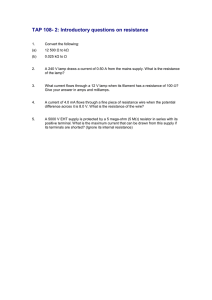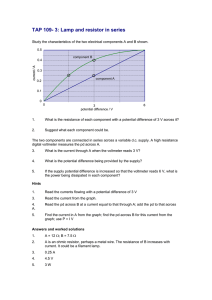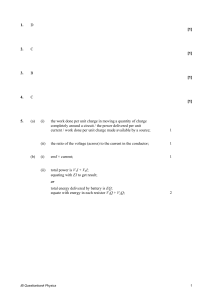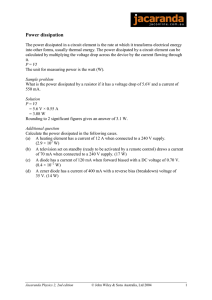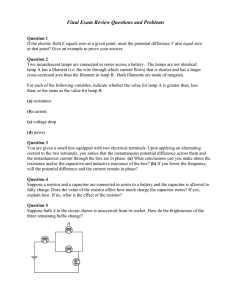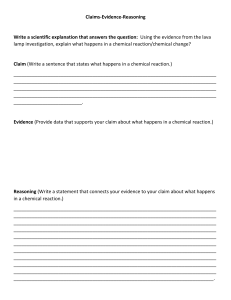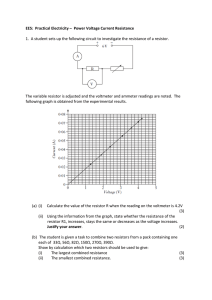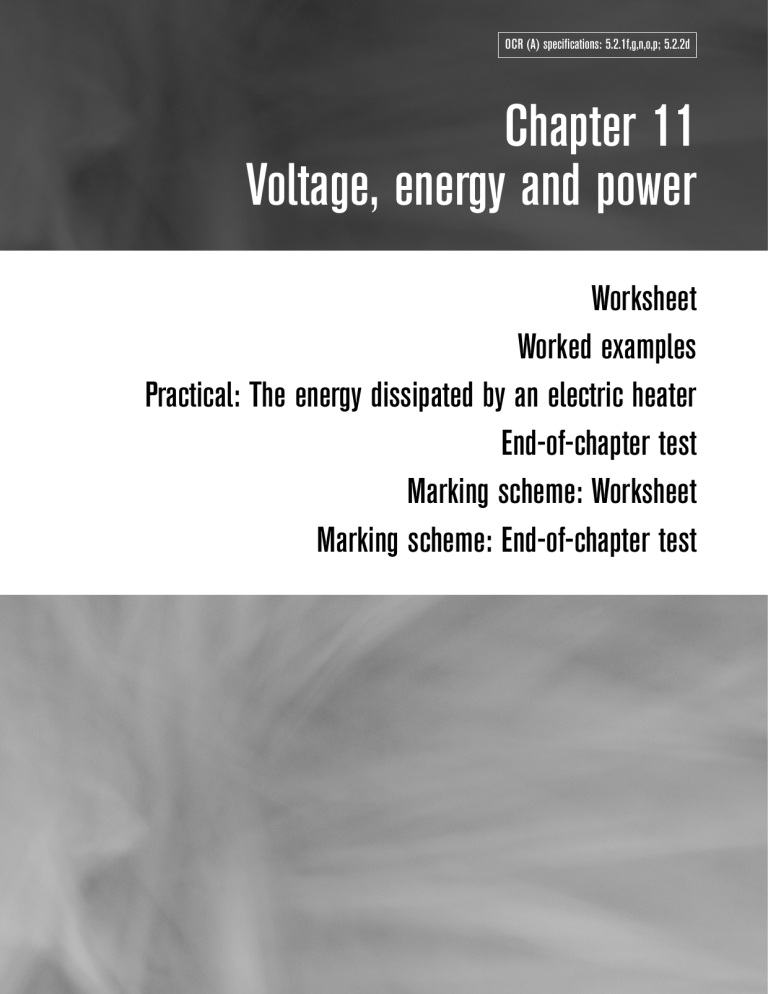
OCR (A) specifications: 5.2.1f,g,n,o,p; 5.2.2d Chapter 11 Voltage, energy and power Worksheet Worked examples Practical: The energy dissipated by an electric heater End-of-chapter test Marking scheme: Worksheet Marking scheme: End-of-chapter test Worksheet Intermediate level 1 A cell has an electromotive force (e.m.f.) of 1.5 V. Calculate the chemical energy transferred when the following charges flow through the cell: a 1 C; [2] b 600 C. [1] 2 The potential difference across a filament lamp is 6.0 V. Explain what this means in terms of energy transfer and charge. [1] 3 Calculate the potential difference across a component that transfers 15 J of energy when a charge of 4.2 C flows through it. 4 5 6 [2] A 12 V, 36 W lamp is operated for 1 hour (3600 s). Calculate: a the energy dissipated by the lamp; [2] b the current in the lamp. [2] Show that 1 kW h is equal to 3.6 MJ. [2] An electric heater of rating 900 W is operated for a total time of 2.0 hours. a How much energy is transferred in joules and in kilowatt-hours? [3] b What is the cost of operating the heater if the cost per kilowatt-hour is 7.5p? [2] Higher level 7 8 9 A 100 Ω resistor can safely dissipate 0.25 W. Calculate the maximum current in the resistor. [3] A filament lamp in a small torch is labelled as ‘1.5 V, 400 mA’. The filament lamp transfers 5.0% of the electrical energy into light and the remainder is dissipated as heat. Calculate: a the power rating of the lamp; [2] b the power radiated as light; [2] c the resistance of the filament lamp. [2] A 60 W table lamp is operated for a total time of 6.0 hours. a How much energy is transferred in kW h? [2] b For how long can a dishwasher of rating 800 W be operated for the same cost as operating the 60 W lamp for 6.0 hours? [2] 11 Voltage, energy and power © Cambridge University Press 2005 103 10 The diagram shows an electrical circuit. 6.0 V X 12 W Y 36 W a Calculate the current in lamp X. b Calculate the ratio: [2] resistance of lamp X resistance of lamp Y [3] Extension 11 The coiled filaments in a mains lamp and a car headlamp are made of the same material and have the same length. Use the information below to calculate the ratio: cross-sectional area of mains lamp filament cross-sectional area of headlamp filament Mains lamp: 230 V, 100 W [4] Car headlamp: 12 V, 36 W 12 The diagram shows two resistance wires connected in series to a power supply. + iron – nickel The resistance wires have the same length and diameter. The resistivity of nickel is six times that of iron. a Which of these two wires will be hotter? Explain your reasoning. [3] b The two wires are now connected in parallel to the same power supply. Explain which of these two wires will be hotter. [3] Total: ––– Score: 45 104 © Cambridge University Press 2005 % 11 Voltage, energy and power Worked examples Example 1 A solar cell delivers a constant current of 30 mA for a period of 2.0 minutes. During this interval, the e.m.f. of the cell is 0.90 V. Calculate the total energy transformed by the solar cell. The energy W transferred is given by: W = VQ In this case, we use the value of the e.m.f. for V. The flow of charge Q is: Q = It = 0.030 × 120 = 3.6 C In this calculation, you must convert the time into seconds and the current into amperes. Hence the energy transformed by the solar cell is W = 0.90 × 3.6 = 3.2 J Tip An alternative route to the answer would be to use the equation: W = IVt Example 2 The diagram shows an electrical circuit. Calculate the power dissipated by the 10 Ω resistor. Use this answer to deduce the power dissipated by the 40 Ω resistor. The power dissipated P is given by: 0.20 A 10 Ω 40 Ω P = I2R Therefore: The current in a series circuit is the same at all points in the circuit. P = 0.202 × 10 = 0.40 W The current in the 40 Ω resistor is the same. The power P dissipated is directly proportional to the resistance R. Hence, the power dissipated by the 40 Ω resistor will be a factor of 4 times more than the 10 Ω resistor. P = 0.40 × 4 = 1.60 W Tip You can also calculate the power dissipated by first calculating the p.d. across the resistor using: V = IR and then using the equation: P = VI 11 Voltage, energy and power © Cambridge University Press 2005 105 Practical The energy dissipated by an electric heater Safety Always take sensible precautions when using mains-operated supplies. Teachers and technicians should follow their school and departmental safety policies and should ensure that the employer’s risk assessment has been carried out before undertaking any practical work. Apparatus • • • • • • • • • immersion heater 100 ml well-lagged calorimeter water digital ammeter digital voltmeter variable d.c. supply switch stopwatch thermometer S I V A water Introduction lagging The rate at which heat is dissipated by a heater (assuming its resistance remains constant) is directly proportional to the square of both voltage and current. The heater should therefore take four times as long to supply a fixed amount of energy when either the current or the voltage is halved. Is this true? In this experiment, you will investigate the heating effect of a heater as the voltage (and hence the current) is varied. calorimeter A small amount of water in a well-lagged calorimeter is heated by a small immersion heater. The amount of energy W supplied to the water (assuming no losses to the environment, calorimeter, etc.) is given by: W = VIt or W = I 2Rt or W= V2 t R where I is the current in the heater, V is the p.d. across the heater and t is the period of heating. For a given change in the temperature of the water: I2 Rt = constant or V2 t = constant R Assuming that the resistance of the heater does not change significantly due to its temperature, we have: I2t = constant or V 2t = constant If I (or V) is halved, then t would need to be four times as great to deliver the same amount of energy. Procedure 1 2 3 106 Set up the apparatus as shown in the diagram. Set the p.d. across the heater to 12 V. Close switch S. It takes some time for the heater itself to ‘warm up’. To get consistent results, start the stopwatch when the temperature of the water has increased by about 2 °C. (Remember to stir the water before measuring the temperature.) © Cambridge University Press 2005 11 Voltage, energy and power 4 Measure the current and the time taken to change the temperature of the water by 4.0 °C. 5 6 7 Record your results in a table. Repeat this procedure for different values of voltage. Do your results confirm that I 2t = constant and V 2t = constant? Guidance for teachers For 120 ml of water in a well-lagged copper calorimeter, the following results were obtained for a temperature change of 4.0 °C: V = 6.0 V I = 8.2 A t = 48 s V = 3.0 V I = 4.1 A t = 185 s 11 Voltage, energy and power © Cambridge University Press 2005 107 End-of-chapter test Answer all questions. 1 2 3 State one difference and one similarity between potential difference (p.d.) and electromotive force (e.m.f.). [2] The p.d. across a filament lamp is 230 V. A charge of 31 C flows through the lamp in a time interval of 60 s. Calculate: a the energy transferred by the lamp; [2] b the power dissipated by the lamp. [2] The diagram below shows an electrical circuit. V 0.25 A 100 Ω 2.0 W 4 5 a Calculate the power dissipated by the resistor. [3] b Calculate the p.d. across the filament lamp. [2] a Define the kilowatt-hour (kW h). [1] b The power rating of a computer is 85 W. It is operated for a period of 5.0 hours per week. For a period of one week, calculate: a the energy transferred by the computer in kW h; [2] ii the cost of operating the computer if the cost per kW h is 7.1p. [2] A resistor of resistance R has a potential difference V across its ends. Write an equation for the power P dissipated by the resistor. b 6 i The p.d. across a resistance wire is 12 V. It dissipates energy at a rate of 6.0 W. i Calculate the resistance of the metal wire. [2] ii State and explain what will happen to the power dissipated by the resistance wire when the p.d. across it is halved. [2] A metal wire of cross-sectional area 7.0 × 10–8 m2 and of length 5.0 m is coiled. The wire dissipates energy at a rate of 40 W when the current in it is 2.5 A. Calculate the resistivity of the metal. Total: ––– Score: 25 108 [1] © Cambridge University Press 2005 [4] % 11 Voltage, energy and power Marking scheme Worksheet 1 a W = VQ [1]; W = 1.5 × 1 = 1.5 J [1] b W = 1.5 × 600 = 900 J [1] 2 A p.d. of 6.0 V across the lamp means that 6.0 J of electrical energy is transferred into heat and light per coulomb of charge flowing through the lamp. [1] 3 V= W [1]; Q 4 a P= b V= W [1]; t P = VI [1]; 15 = 3.57 V ≈ 3.6 V [1] 4.2 W = Pt = 36 × 3600 = 1.3 × 105 J [1] P 36 = = 3.0 A [1] V 12 I= 5 1 kW h is the energy transferred by a 1 kW device operated for 1 hour. P = 1 kW = 1000 W, t = 1 hour = 3600 s [1] 1 kW h = Pt = 1000 × 3600 = 3.6 × 106 J (3.6 MJ) [1] 6 a Energy = 0.9 kW × 2.0 h [1]; energy = 1.8 kW h [1]; energy = 1.8 × 3.6 × 106 ≈ 6.5 MJ [1] b Cost = 1.8 × 7.5p [1]; cost = 13.5p [1] 7 P = I 2R [1] I= P 0.25 = [1] R 100 I = 5.0 × 10–2 A (50 mA) [1] 8 a P = VI [1]; P = 1.5 × 0.40 = 0.60 W [1] b Plight = 0.05 × 0.60 [1]; Plight = 3.0 × 10–2 W [1] c R= V [1]; I R= 1.5 = 3.75 Ω ≈ 3.8 Ω [1] 0.40 9 a Energy = 0.06 kW × 6.0 h [1]; energy = 0.36 kW h [1] b 0.36 = 0.8 × t (t = time in hours) [1] t= 10 a I = b P= 0.36 = 0.45 h (t = 27 minutes) [1] 0.8 P [1]; V I= V2 R so 12 = 2.0 A [1] 6.0 R= V2 [1] P V2 PX PY 36 RX [1]; = 2 = = Ratio RY V PX 12 PY 11 R = ρl A so A= ρl V2 [1]; P = R R ratio = 3.0 [1] so R= V2 [1] P ρl ρ lP P ∝ 2 [1] 2 = V V2 V P 100 Amains 2302 100 × 122 Ratio = = = = 7.6 × 10–3 [1] Acar 36 2 2302 × 36 12 A= 11 Voltage, energy and power © Cambridge University Press 2005 109 12 a In a series circuit the current through the wires is the same. [1] P = I 2R = I 2 ( ρl ) ∝ ρ [1] A The power dissipated is directly proportional to the resistivity ρ of the material. Therefore, the nickel wire gets hotter. [1] b The p.d. across the wires is the same when they are connected in parallel. [1] P= V2 V2 V 2A 1 = = ∝ [1] R ρl ρl ρ A The power dissipated is inversely proportional to the resistivity of the material. Therefore, the iron wire will be hotter. [1] 110 © Cambridge University Press 2005 11 Voltage, energy and power Marking scheme End-of-chapter test 1 Difference: Charges are losing energy for p.d. and gaining energy for e.m.f. (for p.d., energy is transformed from electrical to heat, whereas for e.m.f., energy is transformed into electrical from other forms like chemical, etc.). [1] Similarity: Both are measured in volts (both are defined as: ‘energy transferred per unit charge’). [1] 2 3 4 5 6 W = 230 × 31 = 7.13 × 103 J ≈ 7.1 × 103 J [1] a W = VQ [1]; b P= a P = I 2R [1]; b P = VI [1]; a 1kWh is the energy transferred by a 1kW device operating for a period of 1hour. [1] b i Energy = 0.085 × 5.0 [1]; energy = 0.425 kW h ≈ 0.43 kW h [1] ii Cost = 0.425 × 7.1 [1]; cost = 3.0p [1] a P= V2 [1] R b i R= ii For a given resistance, the power is directly proportional to the square of V2 the p.d. ( P = ∝ V 2 ). [1] Hence the power dissipated by the resistor will R decrease by a factor of 4 if the p.d. is halved. [1] P = I 2R ρ= W [1]; t P= 7.13 × 103 ≈ 120 W [1] 60 P = 0.252 × 100 [1]; V= P 2.0 = = 8.0 V [1] I 0.25 V 2 122 = [1]; P 6.0 so R= R = 24 Ω [1] P 40 = [1]; I 2 2.52 RA 6.4 × 7.0 × 10–8 = [1]; l 5.0 11 Voltage, energy and power P = 6.25 W ≈ 6.3 W [1] R = 6.4 Ω [1] ρ = 8.96 × 10–8 Ω m ≈ 9.0 × 10–8 Ω m [1] © Cambridge University Press 2005 111
